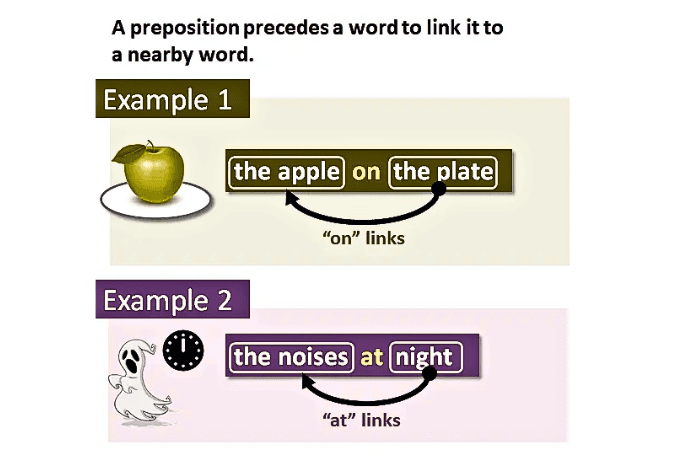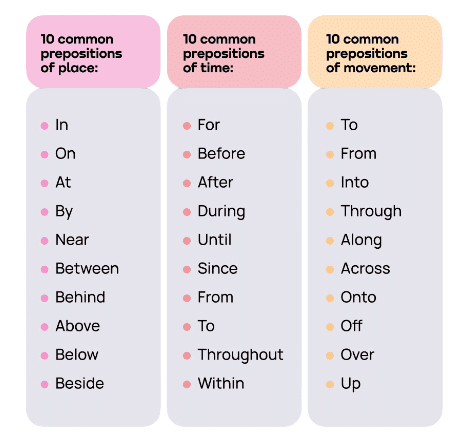The Preposition | English Grammar for Class 6 PDF Download
| Table of contents |

|
| What are Prepositions? |

|
| Types of Prepositions |

|
| Rules for Using Prepositions |

|
| Commonly Confused Prepositions |

|
What are Prepositions?
- Prepositions are essential words in English that help explain the relationship between different parts of a sentence.
- They show where, when, and how something happens.
- Prepositions usually come before a noun or pronoun and are followed by it.

Types of Prepositions
1. Prepositions of Time
These prepositions tell us when something happens. They can refer to a specific time or date.
"At" is used to denote a definite point of time, as,
at 8 am, at 5 O’clock, at sun set, etc.
- The train arrived at 9 O’clock.
- They reached here at dinner time.
"In" is used to indicate a period of time, as,
in August, in spring, in five minutes, in the morning/evening, in 1990 etc.
- Vikrant was born in 1982.
- Christmas is celebrated in December.
"On" is used before the name of days and dates, as,
- On Sunday, on 26th January, on Christmas eve etc.
- I shall come on Friday.
- She left for Delhi on the 10th of May.
"In" denotes at the end of a period of time in future.
"Within" denotes before the end of a period of time in future.
"Till" (or until) means “upto”.
"By" means “not later than”.
- I shall be back within two days.
- I shall wait for you till Monday.
- He will finish this work by March.
"Since" is used for a point of time with Perfect and Perfect Continuous Tenses.
- He has been ill since Monday.
- They have been staying away since July.
"For" is used to denote a period of time in the past, present and future, as,
- He has lived here for five years.
- Devesh lived in Jaipur for eight months.
- Raju wants to stay here for a week.
- Uncle will be staying with us for a month.
"From" is used to denote some point of time in all tenses, as,
- He works from morning till evening.(Present)
- They played from 2 p.m. to 6 p.m. (Past)
- I will work regularly from tomorrow. (Future)
"Before" means “earlier than”, as,
- He came before 8 O’clock.
"After" mean “later than” as,
- We reached there after the meeting.
We use "during" to show something happening for a period of time; as,
- We work during the day and sleep during the night.
- I shall visit you during the vacation.

2. Prepositions of Place
Prepositions of place describe the location or position of something or someone. They help us understand where something is situated or where an action occurs.
- In: Refers to something enclosed or general locations.
- On: Refers to surfaces or specific locations.
- At: Refers to specific points or addresses.
Here are some common prepositions of place, categorized by their usage:
Residence (Countries, Towns, etc.)
- In: Used for general references to larger areas or enclosed spaces.
- "Many people live in cities."
- "He lives in a country."
- At: Used for specific locations, such as the seaside.
- "He lives at the seaside."
- On: Used for specific, often smaller locations, such as an island.
- "He lives on an island."
Residence (Houses, Apartments, etc.)
- In: Used for general references to a type of building or enclosed space.
- "I live in a small house."
- "She lives in a bungalow."
- At: Used for specific addresses.
- "Mrs. Gandhi lives at 10 Janpath."
- In: Used for names of streets and roads.
- "He lives in Mayur Vihar."
- "I live in Sector-14."
Place of Work
- In: Used for buildings or general areas.
- "His father works in a bank."
- On: Used for places of work that are not buildings.
- "Ram works on a farm."
- At: Used for specific places or names.
- "He works at the Public Library."
- In: Used for specific departments or sections.
- "He is a teacher in the Department of English."
3. Prepositions of Movement
Prepositions of movement describe how something or someone moves from one place to another. They show the direction, destination, or path of movement. These prepositions help us understand not just where something is, but also how and where it is moving.
- Toward: Shows the direction of movement.
- Into: Indicates entering or moving inside something.
- Along: Describes movement parallel to something.
- Through: Shows movement from one side to the other, within something.
- Onto: Indicates moving to a position on top of something.
Toward
- Indicates the direction in which something is moving.
- Usage: Used when something or someone is moving in the direction of a specific point or destination.
- Example: "Shefali was running toward us."
Explanation: This sentence shows that Shefali is moving in the direction of "us," meaning she is approaching or heading toward that point.
Into
- Indicates movement from outside to a point inside something.
- Usage: Used when something or someone moves from the outside of an area and enters it.
- Example: "He jumped into the sea."
Explanation: This sentence shows that he moved from outside the sea and entered it, so the action involves entering or going inside the sea.
Along
- Describes movement in a line or path beside or following something.
- Usage: Used when someone or something moves in a direction parallel to a line or edge.
- Example: "They drove along the interstate highway."
Explanation: This sentence indicates that their movement was parallel to the interstate highway, traveling in the direction of the road.
Through
- Indicates movement from one side of an area or object to the other side.
- Usage: Used when someone or something moves from one end or side of something to the other end or side, passing within it.
- Example: "The train passed through the tunnel."
Explanation: This shows that the train moved from one side of the tunnel to the other, traveling inside it.
Onto
- Describes movement from one place to a surface or area on top of something.
- Usage: Used when someone or something moves to a position on top of a surface or object.
- Example: "She climbed onto the roof."
Explanation: This sentence indicates that she moved from below to a position on top of the roof.
Rules for Using Prepositions
Prepositions Work with Nouns and Pronouns
- Prepositions do not have meaning by themselves. They need a noun or pronoun to link them to other parts of the sentence.
- Example: "The cat is on the table."
The preposition on links cat and table.
Placement of Prepositions
- A preposition is placed before a noun or pronoun. This noun or pronoun is called the "object of the preposition."
- Example: "The book is under the bed."
The preposition under links book and bed.
Prepositions of Manner
- These prepositions describe how something is done. They are also known as prepositions of instrument or agent.
- Examples:
- "We work with our hands."
Describes the manner of working. - "Deepak was hit by a bat."
Describes the agent of the action.
- "We work with our hands."
- Common Prepositions: by, with
Commonly Confused Prepositions
For and Since
- Use for to describe a period of time (e.g., "for a month").
- Use since to describe a specific point in time (e.g., "since October").
- Examples:
- "Rohan has been ill for a month." (Period of time)
- "Rohan has been ill since October." (Point in time)
On and Upon
- On refers to a resting position (e.g., "on the desk").
- Upon indicates movement or a starting point (e.g., "leapt upon the wall").
- Examples:
- "Her laptop is on the desk." (Resting position)
- "The cat leapt upon the wall." (Movement)
In and Into
- In indicates a stationary position (e.g., "in the drawer").
- Into indicates movement (e.g., "walked into the classroom").
- Examples:
- "He hid his comic book in the drawer." (Stationary position)
- "The teacher walked into the classroom." (Movement)
Beside and Besides
- Beside means next to (e.g., "beside her father").
- Besides means in addition to (e.g., "besides a house").
- Examples:
- "She was standing beside her father." (Next to)
- "Besides a house, they also have a car and a television." (In addition to)
Between and Among
- Between is used for two things or people (e.g., "between India and the USA").
- Among is used for more than two things or people (e.g., "among the member countries").
- Examples:
- "Trade is good between India and the USA." (Two entities)
- "The WHO circulated guidelines among the member countries." (More than two entities)
Prepositions are important in English as they help explain relationships between different parts of a sentence. Understanding the different types of prepositions and their usage rules will make your writing and speaking clearer and more precise.
|
49 videos|349 docs|46 tests
|
FAQs on The Preposition - English Grammar for Class 6
| 1. What is mechanical engineering? |  |
| 2. What are the key responsibilities of a mechanical engineer? |  |
| 3. What are the typical career paths for mechanical engineers? |  |
| 4. What skills are important for a successful career in mechanical engineering? |  |
| 5. How can someone become a mechanical engineer? |  |





















